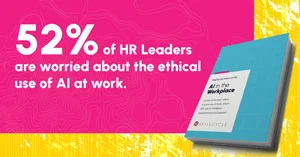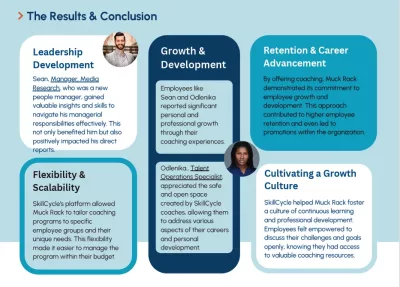Building a culture of belonging for a diverse workforce is an essential part of running a successful business. However, that doesn’t mean the majority of companies are getting it right. In many cases, even with a solid diversity, equity, and inclusion (DEI) team structure, long-term success isn’t guaranteed.
Creating a DEI strategy that will be effective for the long term takes effort — but the payoffs can be significant. Globally, companies with DEI teams were 22% more likely to be viewed as industry leaders with high-caliber talent, according to a survey by LinkedIn.
Protecting your DEI team to reap the long-term benefits this function brings to an organization is crucial, but change doesn’t happen overnight. “DEI is an evergreen process,” says Kristy McCann Flynn, Co-founder and CEO of SkillCycle.
In this article on maintaining your DEI team for the long run, we’ll explore:
- Building an effective DEI team structure
- Why DEI teams aren’t always successful
- Whether DEI teams are being set up to fail
- Where we go from here: The future of DEI strategy
- How organizations can protect their DEI team structures
Building an effective DEI team structure
One DEI leader or team cannot change an entire workplace culture on their own. To create a culture of belonging in your organization, you’ll need to establish a DEI team who can build a strategy, then empower them to implement it across the company.
The ideal DEI team structure may vary based on the size of your organization, but typically will include a director or chief diversity officer (CDO), VPs or program managers, and enough team members to execute your DEI strategy. Their responsibilities may include: building strategy, setting goals, identifying necessary resources, implementation, monitoring and reporting on progress, and engaging other teams.
The most critical element is to engage all other areas of the company in DEI initiatives and ensure accountability in making it a part of how you do business. A commitment must be made at all levels, from the top down, to integrate DEI efforts into the overall corporate strategy.
Why DEI teams aren’t always successful
Inclusion is “a business imperative,” according to McKinsey. Research shows that among diverse workforces, performance improves by 12%, and employees’ intent to stay increases by 20%, says Gartner. And yet, DEI team structure is often the first eroded by layoffs when challenges arise.
DEI teams face three significant challenges when trying to plan, implement, and measure their performance.
1. Definition
Before an organization can succeed with DEI, it must agree on what DEI means. DEI goals may have specific core components, but the ideal outcome is reaching a sense of belonging within an organization.
2. Data
There is a massive amount of data within organizations, particularly within HR and people departments, but much of it isn’t shown in real time. DEI teams are often left without metrics to prove their value.
3. Expanding beyond internal programs
DEI goals should be more than just an internal shift. Companies must decide how they’ll manage and measure it inside and outside of the organization.
“Building a successful DEI team is about defining what the team’s results need to be and what you’re truly looking to do within an organization,” says McCann Flynn. “Are you trying to drive engagement? Are you trying to drive cultural diversity? Are you really trying to drive a sense of belonging?”
Are DEI teams set up to fail?
The challenges of diversity and inclusion in the workplace are varied. In some cases, DEI professionals are quitting. In others, these departments have been hit first during a challenging economic landscape, losing budget and resources. Sometimes there simply isn’t enough momentum to carry the company from planning to implementation to execution.
“We see a lot of natural turnover,” says McCann Flynn — noting that it’s tough to stay in a role when you’re not set up for success — “but are expected to ignite the overall culture of belonging in an organization.”
Many failures stem from stakeholders needing to understand how DEI drives benefits across the organization, especially over the long term. When DEI teams are getting cut, they’re often not showing the value quickly enough. That doesn’t mean the benefits aren’t there, but in any organization, people want to see immediate returns derived from numbers and data.
“Diversity, equity, inclusion does not have a standard playbook of what needs to be measured and managed, and why,” says McCann Flynn.
There can be a disconnect between what an organization may decide is needed to fill gaps in DEI and belonging, and what employees actually need to thrive. Having a DEI team in place is critical to explore these gaps and work to fill them.
“Companies need a better sense of what belonging really is,” says McCann Flynn. “What it can do for the value of the business, the value of all the employees, the value of the product.”
The future of DEI strategy
HR, and DEI specifically, can be revenue drivers for a business, but DEI teams need data to implement their strategy and demonstrate how it drives benefits across the organization. “They need to be able to take the data in a way that’s digestible and easy and shows the return, and not have it stuck in a thousand different systems,” says McCann Flynn.
AI can provide vital data that allow DEI teams to connect storytelling to metrics instead of having information in an array of disparate systems. Backend AI data analytics can show the returns being gained from DEI efforts. These analytics can also demonstrate what an organization is really losing when engagement drops or people leave. AI can bring data to life in real time to proactively show a return on investment (ROI) at every stage.
Companies can look to other organizations to see which are implementing DEI successfully and analyzing the results they’re able to yield by doing so. With better data, it becomes easier to set certain standards of what DEI means, and how it’s being managed and measured.
How can organizations protect their DEI team structures?
The first thing you can do to protect your DEI team (and the benefits it can drive for your company) is to provide the necessary budget, systems, and tools. These will form the necessary foundation for success. Next, connect your DEI strategy to your internal and external corporate goals to get lasting results.
DEI must influence every area of your business to create a true sense of belonging and drive positive outcomes. “It’s far more effective to look at DEI across the entire employee lifecycle, from hiring to promotion to succession,” says McCann Flynn. “Look at how it’s being applied and how it’s driving to overall ROI.”
Companies must integrate DEI into every part of the business for the best return on investment. With a full commitment from all levels of the organization to overcome challenges of diversity and inclusion in the workplace, DEI can drive positive business outcomes over the long term.
Concerned about the future of your DEI team? A quick chat with our customer success team can be the first step in a more proactive approach that helps you avoid losing key team members.








